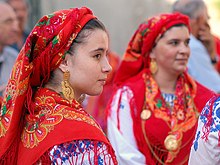
Back المرأة في البرتغال Arabic পৰ্তুগালৰ নাৰী Assamese زنان در پرتغال Persian Condizione della donna in Portogallo Italian Mulheres em Portugal Portuguese Portugaliya ayollari Uzbek
 Two women from Portugal in traditional garb, 2010 | |
| General Statistics | |
|---|---|
| Maternal mortality (per 100,000) | 8 (2010) |
| Women in parliament | 28.7% (2013) |
| Women over 25 with secondary education | 47.7% (2012) |
| Women in labour force | 66.6% (employment rate OECD definition, 2020)[1] |
| Gender Inequality Index[2] | |
| Value | 0.067 (2021) |
| Rank | 15th out of 191 |
| Global Gender Gap Index[3] | |
| Value | 0.766 (2022) |
| Rank | 29th out of 146 |
| Part of a series on |
| Women in society |
|---|
 |
Women in Portugal received full legal equality with Portuguese men as mandated by Portugal's constitution of 1976, which in turn resulted from the Revolution of 1974. Women were allowed to vote for the first time in Portugal in 1931 under Salazar's Estado Novo, but not on equal terms with men. The right for women to vote was later broadened twice under the Estado Novo. The first time was in 1946 and the second time in 1968 under Marcelo Caetano, law 2137 proclaimed the equality of men and women for electoral purposes. By the early part of the 1990s, many women of Portugal became professionals, including being medical doctors and lawyers, a leap from many being merely office employees and factory workers.[4]
- ^ OECD. "LFS by sex and age - indicators". stats.oecd.org. Retrieved 27 April 2018.
- ^ "Human Development Report 2021/2022" (PDF). HUMAN DEVELOPMENT REPORTS. Retrieved 14 November 2022.
- ^ "Global Gender Gap Report 2022" (PDF). World Economic Forum. Retrieved 13 February 2023.
- ^ "Portugal-Women (data as of 1993)". Mongabay.com. Retrieved 3 November 2013.
© MMXXIII Rich X Search. We shall prevail. All rights reserved. Rich X Search